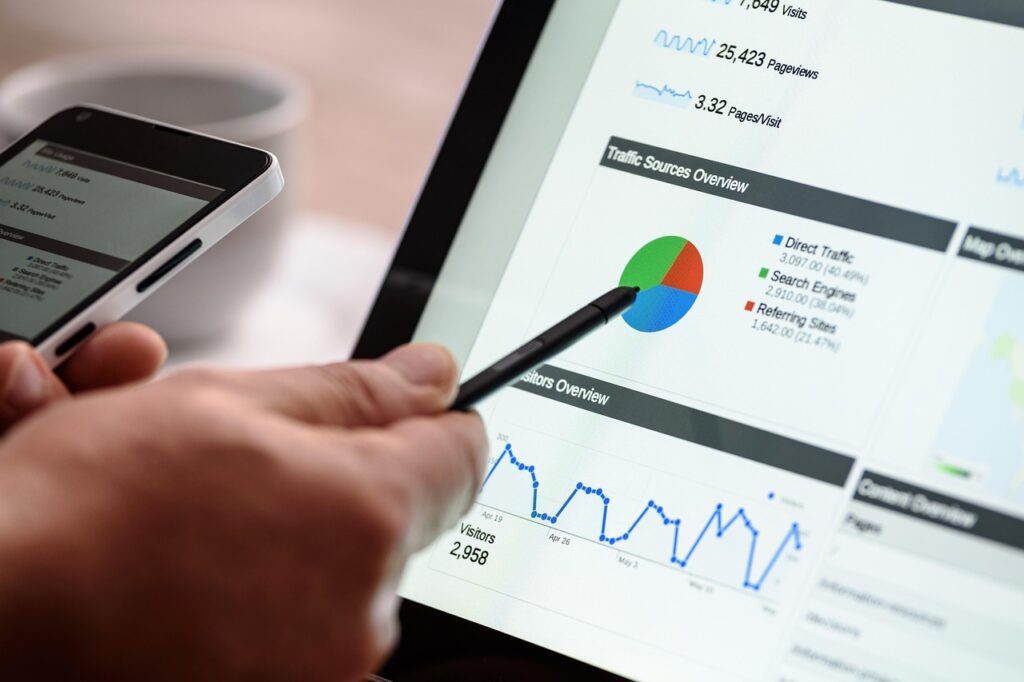
The SEO KPI Guide: Know What Moves the Needle
If organic traffic matters to your business, so does tracking what makes it tick. But just watching rankings or impressions isn’t enough. To measure real SEO performance, and improve it, you need KPIs that cut through the noise and tie directly to your goals.
Let’s break down what SEO KPIs really are, why they matter more than generic metrics, and how to pick the ones that actually push results.
What Are SEO KPIs (and Why You Can’t Skip Them)?
SEO KPIs are your scoreboard. They’re the key metrics that map directly to your strategy’s success, think traffic growth, lead generation, or revenue from organic.
They’re not random stats. They’re picked with intent.
While standard metrics show what’s happening (like pageviews or bounce rate), SEO KPIs show what matters. That might be the number of high-value keywords ranking on page one or the conversion rate from organic visitors. If it doesn’t tie back to business outcomes, it’s just noise.
👉 KPIs = impact-driven
👉 Standard metrics = context only
By focusing on the right KPIs, you cut through vanity data and focus your time, budget, and optimizations where they’ll actually pay off. That’s what separates a solid SEO campaign from one that just checks boxes.
🎯 KPIs vs. Metrics: Why the Difference Matters
Not every data point is a KPI, and confusing the two can derail your strategy fast.
SEO KPIs are:
- Aligned with core business goals (like MQLs, revenue, sign-ups)
- Used to evaluate strategy effectiveness
- Essential for decision-making and prioritization
Standard metrics are:
- Broader performance signals (like sessions, CTR, bounce rate)
- Useful for diagnosing issues, not judging outcomes
- Sometimes disconnected from direct business value
You need both, but don’t mistake “lots of data” for “clear direction.” KPIs give clarity. They show what’s working, what’s broken, and where to scale.
🎯 Why Tracking the Right SEO KPIs Actually Matters
SEO isn’t a guessing game, it’s a system. And KPIs are what keep that system accountable. When you track the right ones, you’re not just watching numbers. You’re steering strategy, spotting weaknesses, and proving ROI.
Here’s why nailing your KPIs is a non-negotiable:
✅ Double Down on What Works
When KPIs are dialed in, you can see exactly which tactics drive results. That means no more wasting time or budget on dead-end strategies. Instead, you double down on what’s moving the needle, faster rankings, better traffic, higher conversions.
🛠 Flag What’s Not Working
KPIs don’t just highlight wins, they spotlight what’s broken. If organic traffic’s up but conversions are flat, or if rankings aren’t translating to clicks, your data will call it out. That’s how smart teams adjust fast and stay ahead.
📢 Report Wins That Stakeholders Understand
SEO can be a black box to non-marketers. But KPIs turn progress into clear, business-aligned numbers, leads, revenue, ROI. When you’re armed with data that actually matters to your CEO or client, the conversation changes.
Bottom line: the right KPIs don’t just guide strategy, they justify it. Align them with your business goals, and you’ll not only boost performance but build real credibility around SEO’s impact.
🧭 How to Choose SEO KPIs That Actually Drive Strategy
Picking the right KPIs isn’t about checking boxes, it’s about making every SEO move count. The best KPIs don’t just track activity, they tie directly into your business goals. That’s how you go from “doing SEO” to building a strategy that scales.

Here’s how to lock in KPIs that matter.
🎯 Step 1: Align KPIs With Business Objectives
Every business has different priorities, your KPIs should reflect that. Start by asking what success looks like beyond rankings. Is it more revenue? Leads? Local exposure? Pick KPIs that zero in on those results.
Examples:
- E-commerce: Focus on organic revenue, product page rankings, or checkout conversion rate from SEO traffic.
- Service businesses: Track local pack impressions, form submissions from organic search, or booked consultations.
- Publishers: Look at organic pageviews, scroll depth, or average time on site to measure content impact.
🛠 Step 2: Track with Tools That Show the Whole Picture
Once you’ve defined your KPIs, wire up the right tools to track them. Platforms like Google Analytics, Search Console, Ahrefs, and SEMrush can surface the data, but only if you’ve configured conversions and goals properly.
No tracking = no strategy.
📏 Step 3: Set Targets That Mean Something
Raw numbers are just noise without context. Set specific, measurable KPI targets based on your historic performance and industry benchmarks. That’s how you know whether your strategy is crushing it… or just coasting.
Good KPIs are:
- Specific
- Actionable
- Tied to business value
- Easy to benchmark and revisit
Define them right, and they’ll be your roadmap, not just a dashboard.
📊Ongoing Monitoring and KPI Analysis
Setting up tracking is just the start, real SEO wins come from what you do with the data. Build a tight reporting cadence: weekly for quick pivots, monthly for pattern spotting, and quarterly for strategy shifts.
But don’t just show charts. Add context. If a KPI moves, explain why. Was it a ranking drop? A content push? Algorithm turbulence? Everyone on the team, from SEOs to stakeholders, should know what each number means and why it matters.
Use KPIs to drive action. If a page’s performance tanks, fix the issue. Update content. Refine title tags.
Streamline internal links. Test changes, track the impact, and repeat. Whether it’s swapping meta descriptions or adjusting content structure, every tweak should map back to a KPI. No guesswork, just data-backed decisions.
And as goals shift, so should your KPIs. Priorities evolve. Traffic alone might take a back seat to leads, sales, or engagement.
Keep your metrics aligned with business objectives. Static KPIs in a dynamic environment mean missed opportunities. Stay flexible, stay relevant, and keep your tracking loop tight.
📌 Key SEO KPIs to Track
If you want to level up SEO, don’t just watch rankings, track what actually drives results. These KPIs cut through vanity stats and show where your strategy wins, breaks, or stalls.
Organic Traffic
This one’s the baseline. Organic traffic tells you how many users landed on your site from unpaid search. More importantly, it shows if Google thinks your content deserves to be seen. Big picture? Traffic up = visibility up. If it’s flat or dropping, something’s broken — maybe rankings, maybe indexing, maybe just intent mismatch. Dig fast.
Organic Visibility
Visibility = how often your site shows up in search results. Even if users don’t click, your content needs to be there. Use Search Console to pull clicks, impressions, CTR, and position. Tools like Ahrefs and SEMrush give you visibility scores based on keyword rankings and search volume. Watch this to track reach. If it’s moving up, your pages are climbing.
Branded vs. Non-Branded Traffic
Branded means users searched for you. Non-branded means they didn’t know you yet. You need both. Branded traffic shows brand strength. Non-branded shows keyword dominance. If 90% of your traffic is branded, your SEO isn’t bringing in new people — it’s just cleaning up behind your marketing.
Organic Traffic Conversions
Traffic’s great. Conversions are better. Track how many organic users take action — buy, sign up, book, fill out a form. Set goals in GA or GA4 and watch the rate:
(Organic Conversions ÷ Organic Sessions) × 100
This tells you whether SEO is just driving views — or real value. No conversions = wrong traffic, broken funnel, or weak content.
Keyword Rankings
Still matters. Rankings tell you how your pages stack up for your target queries. If you’re not in the top 10, you’re not visible. Watch gains, losses, and what keywords are doing the heavy lifting. Don’t obsess over every dip — track trends and focus on terms that drive money, not fluff.
Click-Through Rate (CTR)
CTR shows if your listings get clicks — or get ignored. High impressions + low CTR = your titles or meta descriptions need work. Rewrite them to grab attention and match search intent. If CTR goes up, traffic usually follows. Google sees that signal, too.
Number and Quality of Backlinks
Backlinks still matter. Not all links count. You want quality over quantity — relevant, trusted, contextual links. Use Ahrefs, SEMrush, or Moz to audit your profile. Track referring domains, anchor text, toxic links, and what pages attract links naturally. If your backlinks are junk, your rankings will be too.
Domain Authority
Not a Google metric — but still useful. Moz’s DA gives a quick read on your overall authority compared to others. It’s driven by link quality, site structure, and domain history. Use it to track progress over time — just don’t build strategy around it.
Bounce Rate
If users land and leave instantly, something’s off. Bounce rate tells you if your page matches intent — or if people bailed because they didn’t find what they came for. High bounce isn’t always bad, but if your core landing pages are leaking traffic, fix the experience. Fast.
Page Load Time
Slow sites kill rankings, UX, and conversions. Every second counts — literally. Use PageSpeed Insights or Lighthouse. Compress images, defer scripts, kill bloated code. A site that loads in 5 seconds feels ancient. Get it under 2.
Average Engagement Time
This isn’t just time on page — it’s how long users actually interact. Google Analytics 4 tracks this. If people are scrolling, clicking, watching, reading — you’re doing it right. If engagement’s low, rework the content. Boring doesn’t rank.
Session Duration
Longer sessions mean users are exploring. It’s a good sign — especially for top-of-funnel content. Use this alongside engagement and bounce rate to spot weak spots in your flow. If users stick around, your internal linking and content structure are pulling their weight.
SEO ROI
This is the number your boss cares about.
(Revenue from SEO − Cost of SEO) ÷ Cost of SEO
Revenue attribution takes work — track organic conversions, use attribution models, and estimate value per lead or sale. If SEO ROI is positive, you’re winning. If not, time to revisit your content, keywords, and technical structure.
Social Signals
Not a direct ranking factor, but a nice boost. Likes, shares, and comments = distribution and relevance.
Good content gets shared. Shared content gets seen. Seen content gets linked. It’s a chain reaction. Track which content gets traction, it’s usually the kind that also earns links.
Cost Per Acquisition (CPA)
Even organic traffic has a cost. CPA tells you how efficient SEO is at bringing in customers. Lower CPA = higher SEO value. Compare it against paid, social, and email to see what’s pulling weight. If your SEO CPA is climbing, fix what’s leaking traffic or killing conversions.
🔍 Advanced SEO Metrics and KPIs
Once your primary KPIs are in place, it’s time to go deeper. These advanced metrics offer more precise insight into how your SEO tactics are playing out across visibility, engagement, and local performance. They won’t show up in every default report, but they often reveal what’s actually driving outcomes.

Google Business Profile Metrics
If local traffic is part of your strategy, your Google Business Profile needs to be treated like a core asset. Formerly Google My Business, GBP controls how your brand appears across Google Search and Maps.
It connects high-intent local users with your business info, and it often shows up before your site does. Most teams ignore the data behind it, which means they’re flying blind.
Here’s what to track if you want to do it right:
Search Queries
These are the exact terms people enter before your profile appears. They reveal real-time demand and show whether your GBP is aligned with how local users search. If the queries don’t match your offer, your optimization is off.
Customer Actions
This tracks what users do after seeing your profile, including website visits, calls, and requests for directions. These actions reflect real engagement, not just impressions. If people are landing on your listing but not clicking, it’s time to fix the content.
Views, in Search and Maps
Total views tell you how often your profile shows up, but the breakdown matters. Direct views come from users who search for you by name, while discovery views show up when users search for products, services, or categories. Discovery growth means your SEO is working.
Photo Views and Quantity
Google compares your photos against those of similar businesses. If your images get fewer views, they aren’t attracting attention. Better visuals drive engagement, especially on mobile. Update frequently, track performance, and stay ahead of your local competition.
Monitoring these metrics lets you turn your GBP into a high-converting local asset. Every data point tells you how visible, useful, and competitive your business appears in local search. If you rely on local traffic, this is where attention belongs.
🧭 SEO-Optimized Site Architecture and Internal Links
Site structure isn’t decoration, it’s infrastructure. If your internal links are sloppy or your architecture’s too deep, search engines struggle and users bounce. A tight, well-linked layout makes crawling easier, keeps important pages close to the surface, and helps your SEO scale without breaking.
Here’s what to track if you want architecture that pulls its weight:
Click Depth
This tells you how far a page sits from your homepage. Fewer clicks = higher priority.
Pages buried three, four, five clicks deep? They’re sending the wrong signal. Google sees them as low value, and users probably never find them. Flatten your structure, pull key pages closer, and clean up any navigation dead ends.
Internal Link Distribution
Internal links decide where authority flows. This metric shows which pages get link equity and which ones get ignored.
If your top product or service page has three internal links and a random blog post has twelve, something’s off. Spread links with purpose, not evenly. Link from strong pages to key assets and use descriptive anchor text every time.
Page Crawl Frequency
Google crawls what it thinks matters. If a page gets hit regularly, it means Google trusts it’s active and important. If it’s barely crawled, it’s either too deep, poorly linked, or outdated. Use this data to prioritize updates. If a high-converting page isn’t being crawled, fix that now.
Orphan Pages
No internal links = no visibility. Orphan pages sit outside your navigation and internal structure, meaning crawlers might skip them completely.
They don’t pass value, they don’t get traffic, and they don’t belong. Either link them back into your flow or cut them loose. Orphans kill crawl efficiency.
A solid internal structure makes everything else easier, crawling, indexing, ranking, and navigating. Audit it, fix weak spots, and push authority where it matters most. If Google can’t follow your links, it won’t rank your pages. Simple as that.
Why SEO KPIs Aren’t Just Data — They’re Your Entire Strategy
SEO KPIs aren’t vanity metrics, they’re your strategy in numbers. They show what’s landing, what’s lagging, and what to fix next. When your KPIs align with real business goals, not just impressions or rankings, you stop chasing traffic and start driving results that actually matter.
Tracking the right KPIs keeps your SEO grounded. You’re not reacting to noise or chasing gut feelings.
You’re making decisions based on performance, patterns, and movement. That means you can double down on what works, drop what doesn’t, and stay focused on metrics that tie directly to growth, leads, revenue, visibility, or conversions.
The difference between general metrics and KPIs isn’t just technical, it’s tactical. Metrics show performance in broad strokes.
KPIs highlight cause and effect. If organic traffic drops, a general metric might show you bounce rate. A KPI shows that your core product page lost rankings for a high-intent keyword, and tells you exactly where to go fix it. That precision is what makes SEO scalable.
But KPIs only work if you actually use them. Plug them into your regular workflow, not just your monthly reports. Set baselines, track change, build hypotheses, test, and refine.
Your SEO strategy should evolve based on what the data is saying week after week, not just during quarterly reviews. If you’re not making tactical adjustments in real time, you’re missing out.
Market conditions change, user behavior shifts, algorithms evolve, and your SEO needs to move with them.
Static KPIs in a dynamic environment won’t hold up.
Build flexibility into your tracking process, revisit what you measure, and don’t be afraid to swap out KPIs that no longer map to your goals. Relevance is everything.
Done right, KPIs don’t just measure SEO, they power it. They tell search engines that your site deserves to be seen. They tell stakeholders where their investment is going. And they tell your team exactly where to focus next.
So treat them like what they are: the backbone of smart SEO. Track them ruthlessly, interpret them clearly, and act on them fast. That’s how rankings stick, visibility scales, and business goals actually get hit.





